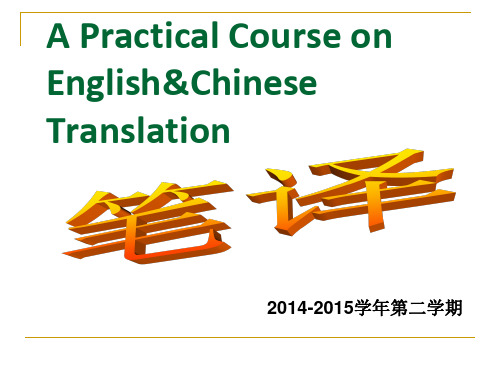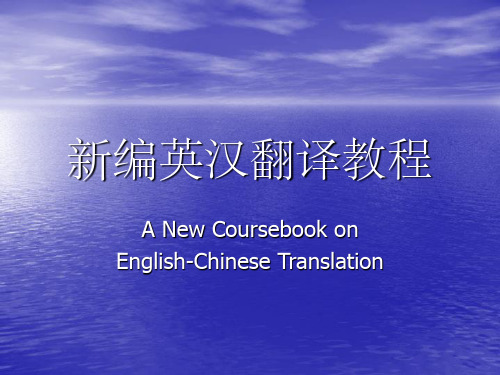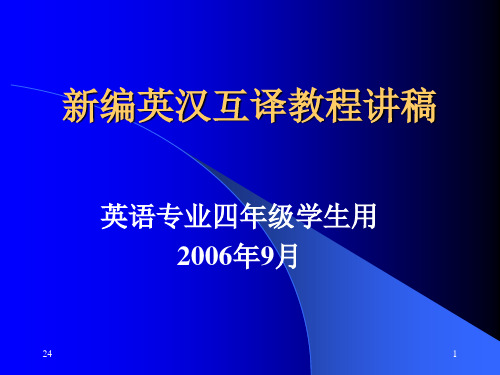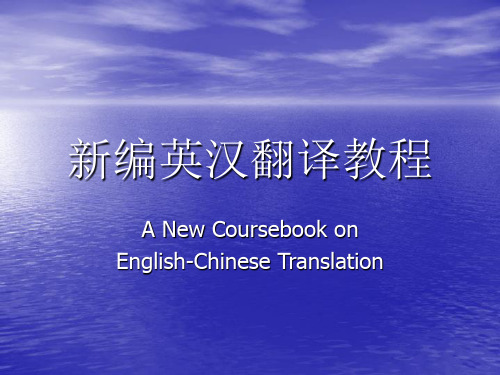新编英汉翻译教程 第一章 PPT
合集下载
英汉翻译教程第一讲完整版.ppt

11. Constant dripping wears away a stone. 11.水滴石穿.
12. Creep before you walk.
12. 循序渐进。
13. Don't put the cart before the horse.
13. 不要本末倒置。
14. Don't trouble troubles until trouble troubles you.
11. Constant dripping wears away a stone. 12. Creep before you walk. 13. Don't put the cart before the horse. 14. Don't trouble trouble until trouble
境和风俗习惯的影响而具有不同的特点。 Drug : 药; 大麻(美俚)
1.2.5 社会政治
一些词语的意义,有时与社会政治密切相关。就 是说,社会制度相同,有关文化之间的差异就比 较少;社会制度不同, 差异就相对地多一些。如:
working class; peasant propaganda; Exploit (开发利用、获取利润) 汉语中是:“剥削”
1.2.6 文学艺术
文学艺术反映一个民族的感情色彩。 对待同一事物, 不同民族的文化感情色彩可能完全不同
Dragon, dog, ox
不同文化艺术中,人们还常常用不同的事物表达相 同的思想。
Work like a horse 像老黄牛一样干活。
As strong as a horse As stupid as a goose
Scope of translation
《新编英汉翻译教程》课件

意译
侧重于传达原文的意义和精神, 不拘泥于原文的句式和表达方式 ,进行适当的调整和改写。
增词法与减词法
增词法
整、流畅。
减词法
在翻译过程中,删除原文中一些不必 要的词汇或短语,使译文更加简洁、 明了。
词序调整与语态转换
词序调整
句法对比
总结词
句法翻译技巧
详细描述
在进行英汉翻译时,需要掌握一定的句法翻译技巧。例如,可以采用拆句、合并、调整语序等方法, 使译文更加符合汉语表达习惯。同时,需要注意句子的逻辑关系和语义连贯性,避免出现断句或语义 不明的情况。
篇章对比
总结词
篇章结构差异
详细描述
英语和汉语在篇章结构方面存在较大差异。英语中篇章结构 较为严谨,常用主题句和段落来组织文章。而汉语中篇章结 构则较为灵活,常通过语义和语境来组织文章。
新闻翻译
总结词
注重时效性和信息传递
详细描述
新闻翻译要求快速、准确地传递信息,确保译 文能够及时地呈现新闻事件的最新进展。
总结词
关注新闻价值和语言风格
详细描述
新闻翻译需要关注新闻价值和语言风格,确保译文 具有新闻的客观性、准确性和可读性。
总结词
了解新闻行业规范和惯例
详细描述
新闻翻译需要了解新闻行业规范和惯例,以确保译文符 合新闻报道的规则和要求。
根据中文的语法和表达习惯,调整原 文中的词序,使译文更加符合中文的 表达方式。
语态转换
将原文中的被动语态转换为中文的主 动语态,或将原文中的主动语态转换 为中文的被动语态,以使译文更加自 然、流畅。
PART 04
翻译实践
文学翻译
总结词
注重语言艺术和审美体验
01
侧重于传达原文的意义和精神, 不拘泥于原文的句式和表达方式 ,进行适当的调整和改写。
增词法与减词法
增词法
整、流畅。
减词法
在翻译过程中,删除原文中一些不必 要的词汇或短语,使译文更加简洁、 明了。
词序调整与语态转换
词序调整
句法对比
总结词
句法翻译技巧
详细描述
在进行英汉翻译时,需要掌握一定的句法翻译技巧。例如,可以采用拆句、合并、调整语序等方法, 使译文更加符合汉语表达习惯。同时,需要注意句子的逻辑关系和语义连贯性,避免出现断句或语义 不明的情况。
篇章对比
总结词
篇章结构差异
详细描述
英语和汉语在篇章结构方面存在较大差异。英语中篇章结构 较为严谨,常用主题句和段落来组织文章。而汉语中篇章结 构则较为灵活,常通过语义和语境来组织文章。
新闻翻译
总结词
注重时效性和信息传递
详细描述
新闻翻译要求快速、准确地传递信息,确保译 文能够及时地呈现新闻事件的最新进展。
总结词
关注新闻价值和语言风格
详细描述
新闻翻译需要关注新闻价值和语言风格,确保译文 具有新闻的客观性、准确性和可读性。
总结词
了解新闻行业规范和惯例
详细描述
新闻翻译需要了解新闻行业规范和惯例,以确保译文符 合新闻报道的规则和要求。
根据中文的语法和表达习惯,调整原 文中的词序,使译文更加符合中文的 表达方式。
语态转换
将原文中的被动语态转换为中文的主 动语态,或将原文中的主动语态转换 为中文的被动语态,以使译文更加自 然、流畅。
PART 04
翻译实践
文学翻译
总结词
注重语言艺术和审美体验
01
新编英汉翻译教程第一章翻译概论ppt课件

• 一个中学老师把KFC肯德基店里的广告标语“We do chicken right!”发给学生练习翻译,结果有如下答案:
•
01. 我们做鸡是对的!
•
02. 我们就是做鸡的!
•
03. 我们有做鸡的权利!
•
04. 我们只做鸡的右半边!
•
05. 我们只做右边的鸡!
“雪亮工程"是以区(县)、乡(镇) 、村( 社区) 三级综 治中心 为指挥 平台、 以综治 信息化 为支撑 、以网 格化管 理为基 础、以 公共安 全视频 监控联 网应用 为重点 的“群 众性治 安防控 工程” 。
“雪亮工程"是以区(县)、乡(镇) 、村( 社区) 三级综 治中心 为指挥 平台、 以综治 信息化 为支撑 、以网 格化管 理为基 础、以 公共安 全视频 监控联 网应用 为重点 的“群 众性治 安防控 工程” 。
Types of translation
• 3. According to styles (page 5) • 1) practical writings (应用文体)
English Dictionary • translation: the process of changing something that is written
or spoken into anther language. ----Oxford English Dictionary • Translating consists in reproducing in the receptor language
“雪亮工程"是以区(县)、乡(镇) 、村( 社区) 三级综 治中心 为指挥 平台、 以综治 信息化 为支撑 、以网 格化管 理为基 础、以 公共安 全视频 监控联 网应用 为重点 的“群 众性治 安防控 工程” 。
《新编英汉翻译教程》课件

回顾中国翻译史的重要 事件和人物。
第二章 翻译理论
1 翻译等效性理论
探讨翻译中的等效性原则及其在实践中的应用。
2 动态对等理论
介绍动态对等理论及其对翻译实践的影响。
3 准确、信达、美观
解读翻译过程中的准确性、传达性和美观性等要素。
第三章 翻译方法
1
活学活用
2
分享一些实用的翻译方法和技巧,
帮助提升翻译质量。
2
翻译员的必备素质
讨论翻译员需要具备的技能和品质。
3
翻译行业的未来展望
展望翻译行业的发展趋势和未来机遇。
《新编英汉翻译教程》 PPT课件
这是一份关于《新编英汉翻译教程》的PPT课件,我们将一同探讨翻译的概述、 理论、方法、实践、质量控制、语言能力、翻译工具以及翻译职业发展。
第一章 翻译概述
翻译定义
探索翻译的本质及其在 不同领域中的应用。
翻译的分类
介绍翻译的不同类型, 如文学翻译、科技翻译 等。
中国翻译史概述
3
直译与意译
比较直译和意译的优缺点,讲解 如何在翻译中进行取舍。
翻译技巧
介绍一些常用的翻译技巧,如拆 句翻译和转换语序等。
第四章 翻译实践
社科类翻译实践
讨论翻译社会科学类文本时 的技巧和挑战。
科技类翻译实践
探索在科技领域中翻译的要 点和专业术语的处理。
ห้องสมุดไป่ตู้
文学类翻译实践
分享文学翻译的艺术和技巧, 以及如何处理文学作品中的 文化差异。
第五章 翻译质量控制
1 翻译质量评估标准 2 翻译质量提升方法 3 翻译过程管理
介绍翻译质量评估的 标准和方法。
分享一些提高翻译质 量的实用方法和技巧。
第二章 翻译理论
1 翻译等效性理论
探讨翻译中的等效性原则及其在实践中的应用。
2 动态对等理论
介绍动态对等理论及其对翻译实践的影响。
3 准确、信达、美观
解读翻译过程中的准确性、传达性和美观性等要素。
第三章 翻译方法
1
活学活用
2
分享一些实用的翻译方法和技巧,
帮助提升翻译质量。
2
翻译员的必备素质
讨论翻译员需要具备的技能和品质。
3
翻译行业的未来展望
展望翻译行业的发展趋势和未来机遇。
《新编英汉翻译教程》 PPT课件
这是一份关于《新编英汉翻译教程》的PPT课件,我们将一同探讨翻译的概述、 理论、方法、实践、质量控制、语言能力、翻译工具以及翻译职业发展。
第一章 翻译概述
翻译定义
探索翻译的本质及其在 不同领域中的应用。
翻译的分类
介绍翻译的不同类型, 如文学翻译、科技翻译 等。
中国翻译史概述
3
直译与意译
比较直译和意译的优缺点,讲解 如何在翻译中进行取舍。
翻译技巧
介绍一些常用的翻译技巧,如拆 句翻译和转换语序等。
第四章 翻译实践
社科类翻译实践
讨论翻译社会科学类文本时 的技巧和挑战。
科技类翻译实践
探索在科技领域中翻译的要 点和专业术语的处理。
ห้องสมุดไป่ตู้
文学类翻译实践
分享文学翻译的艺术和技巧, 以及如何处理文学作品中的 文化差异。
第五章 翻译质量控制
1 翻译质量评估标准 2 翻译质量提升方法 3 翻译过程管理
介绍翻译质量评估的 标准和方法。
分享一些提高翻译质 量的实用方法和技巧。
新编汉英翻译教程(第二版)课时PPT

(ii) social context: the objective environment in which the addresser produces and the addressee interprets an utterance, such as settings for communication, the status of and the relationship between the addresser and addressee, their social and backgrounds; (iii) cognitive environment: any experiences, background knowledge or other which contribute to communication and cognition(何 自然, 1997:210).
Restrictive function is one of the major functions of context and also playing an important part in meaning understanding. I never had much in seeing you. There was no love lost between us at any time, I think. 我向来不大看到你,咱们两人之间大 概什么时候都不曾有过好感。
So writers today should take heart. We could dress like Lady Gaga and hang from a cage at a Yankees game — if any of us looked as good near-naked, that is. 所以今天的作家应该鼓足勇气。 只要我们 中任何人有几分姿色,我们就可以打扮成 嘎嘎夫人那样,在洋基队比赛中将自己挂 在笼子状的裙子里---几近裸体。
新英汉翻译课件教程 Chapter 1 翻译概论共36页文档

文 家 。汉 族 ,东 晋 浔阳 柴桑 人 (今 江西 九江 ) 。曾 做过 几 年小 官, 后辞 官 回家 ,从 此 隐居 ,田 园生 活 是陶 渊明 诗 的主 要题 材, 相 关作 品有 《饮 酒 》 、 《 归 园 田 居 》 、 《 桃花 源 记 》 、 《 五 柳先 生 传 》 、 《 归 去来 兮 辞 》 等 。
1
0
、
倚
南
窗
以
寄
傲
,
审
容
膝
之
易
安
。
6、最大的骄傲于最大的自卑都表示心灵的最软弱无力。——斯宾诺莎 7、自知之明是最难得的知识。——西班牙 8、勇气通往天堂,怯懦通往地狱。——塞内加 9、有时候读书是一种巧妙地避开思考的方法。——赫尔普斯 10、阅读一切好书如同和过去最杰出的人谈话。——笛卡儿
Thank you
新英汉翻译课件教程 Chapter 1 翻译 概论
6
、
露凝无游氛 Nhomakorabea,
天
高
风
景
澈
。
7、翩翩新 来燕,双双入我庐 ,先巢故尚在,相 将还旧居。
8
、
吁
嗟
身
后
名
,
于
我
若
浮
烟
。
9、 陶渊 明( 约 365年 —427年 ),字 元亮, (又 一说名 潜,字 渊明 )号五 柳先生 ,私 谥“靖 节”, 东晋 末期南 朝宋初 期诗 人、文 学家、 辞赋 家、散
1
0
、
倚
南
窗
以
寄
傲
,
审
容
膝
之
易
安
。
6、最大的骄傲于最大的自卑都表示心灵的最软弱无力。——斯宾诺莎 7、自知之明是最难得的知识。——西班牙 8、勇气通往天堂,怯懦通往地狱。——塞内加 9、有时候读书是一种巧妙地避开思考的方法。——赫尔普斯 10、阅读一切好书如同和过去最杰出的人谈话。——笛卡儿
Thank you
新英汉翻译课件教程 Chapter 1 翻译 概论
6
、
露凝无游氛 Nhomakorabea,
天
高
风
景
澈
。
7、翩翩新 来燕,双双入我庐 ,先巢故尚在,相 将还旧居。
8
、
吁
嗟
身
后
名
,
于
我
若
浮
烟
。
9、 陶渊 明( 约 365年 —427年 ),字 元亮, (又 一说名 潜,字 渊明 )号五 柳先生 ,私 谥“靖 节”, 东晋 末期南 朝宋初 期诗 人、文 学家、 辞赋 家、散
新编英汉翻译教程 ppt

发现自我,如实地表现自我,你自然会为人 们所喜欢——为那些尊重你的真正个性的人 们所喜欢。
Where do you expect Shanghai to be in five years?
你预计今后五年上海的发展目 标如何?
Public opinion plays a vital and healthy role in the political realm.
译文1:公共舆论在政治领域起着生 命力的、健康的作用。
译文2: 舆论在政治领域起着极其重 要的、有益的作用。
什么是好的n?
翻译的两类问题:一类是译文语
义基本符合原文,但汉语表达有欠正 确;另一类是汉语表达尚有可读性, 但译文语义不符原文。
目前翻译界普遍接受的,也是作 为一般翻译学习者必须努力掌握的标 准,简而言之是两条:忠实 (Faithfulness) 和流畅 (Smoothness)。
新编英汉翻译教程
A New Coursebook on English-Chinese Translation
严复:信 达 雅
Faithfulness, fidelity, truthfulness Smoothness, expressiveness Elegancy
德国译学教授 Wolfram Wilss 在 The Science of Translation:Problems & Methods一书中说: Translation is not simply a matter of seeking other words with similar meaning, but of finding appropriate ways of saying things in another language. Translating is always meaning-based, i.e. it is the transfer of meaning instead
Where do you expect Shanghai to be in five years?
你预计今后五年上海的发展目 标如何?
Public opinion plays a vital and healthy role in the political realm.
译文1:公共舆论在政治领域起着生 命力的、健康的作用。
译文2: 舆论在政治领域起着极其重 要的、有益的作用。
什么是好的n?
翻译的两类问题:一类是译文语
义基本符合原文,但汉语表达有欠正 确;另一类是汉语表达尚有可读性, 但译文语义不符原文。
目前翻译界普遍接受的,也是作 为一般翻译学习者必须努力掌握的标 准,简而言之是两条:忠实 (Faithfulness) 和流畅 (Smoothness)。
新编英汉翻译教程
A New Coursebook on English-Chinese Translation
严复:信 达 雅
Faithfulness, fidelity, truthfulness Smoothness, expressiveness Elegancy
德国译学教授 Wolfram Wilss 在 The Science of Translation:Problems & Methods一书中说: Translation is not simply a matter of seeking other words with similar meaning, but of finding appropriate ways of saying things in another language. Translating is always meaning-based, i.e. it is the transfer of meaning instead
新编英汉互译教程讲稿.ppt

24
4
1.1 The Origin, Development and Function of Translation
The origin of translation:
In Europe the liberated Greek slave Livius Andronicus rendered Odyssey into Latin verse in about 240 B.C.
德国、日本等等。)
Translation after 1949
Translation since reform and opening up
24
6
1.1 The Origin, Development and Function of Translation
Functions of translation
24
9
1.2 Definition of Translation
Translating consists in reproducing in the receptor language the closest natural equivalent of the source language message, first in terms of meaning and secondly in terms of style. --Eugene Nida
新编英汉互译教程讲稿
英语专业四年级学生用 2006年9月
24
1
Part One Basic Theories of Translation
24
2
Task for today’s lesson
Chapter 1 A Brief Discussion of
新编汉英翻译教程(第二版)课时PPT

技术创新推动行业发展
人工智能、机器翻译等技术的发展将为汉英翻译行业带来 新的机遇和挑战,译者需要紧跟技术发展,不断提升自己 的竞争力。
THANKS FOR WATCHING
感谢您的观看
受到原文的文化内涵。
跨文化意识培养
培养译者的跨文化意识,提高其 在翻译过程中处理文化因素的能
力和水平。
翻译项目管理
项目计划制定
根据翻译项目的需求和要求,制定详细的项目计 划和时间表。
团队协作与沟通
有效组织和管理团队成员,确保翻译项目顺利进 行,及时解决项目过程中出现的问题和困难。
质量监控与评估
对翻译项目进行质量监控和评估,确保译文质量 符合客户要求和行业标准。
总结词
关注跨文化交流和沟通
详细描述
商务翻译需要关注跨文化交流和沟通的问题,能够准确传 达不同文化背景下的商业意图和需求,同时注重译文的流 畅性和可读性,使译文更加符合目标受众的文化习惯和商 业思维。
04 汉英翻译进阶
高阶翻译技巧
语义分析
深入理解原文含义,把握原文的 逻辑关系和深层含义,确保译文
准确传达原文意义。
总结词
强调客观性和中立性
详细描述
新闻翻译需要保持客观和中立的立场,避免在译文中加入 个人观点或偏见,同时要注重译文的准确性和流畅性,确 保译文能够客观地反映新闻事实。
总结词
关注语言风格和表达方式
详细描述
新闻翻译需要关注语言的风格和表达方式,根据不同的新 闻类型和媒体平台,采用适当的语言风格和表达方式,使 译文更加符合媒体平台的定位和受众需求。
学生的跨文化意识,使他们能够更好地理解和传递原文的文化内涵。
未来学习与研究方向
深化理论学习
人工智能、机器翻译等技术的发展将为汉英翻译行业带来 新的机遇和挑战,译者需要紧跟技术发展,不断提升自己 的竞争力。
THANKS FOR WATCHING
感谢您的观看
受到原文的文化内涵。
跨文化意识培养
培养译者的跨文化意识,提高其 在翻译过程中处理文化因素的能
力和水平。
翻译项目管理
项目计划制定
根据翻译项目的需求和要求,制定详细的项目计 划和时间表。
团队协作与沟通
有效组织和管理团队成员,确保翻译项目顺利进 行,及时解决项目过程中出现的问题和困难。
质量监控与评估
对翻译项目进行质量监控和评估,确保译文质量 符合客户要求和行业标准。
总结词
关注跨文化交流和沟通
详细描述
商务翻译需要关注跨文化交流和沟通的问题,能够准确传 达不同文化背景下的商业意图和需求,同时注重译文的流 畅性和可读性,使译文更加符合目标受众的文化习惯和商 业思维。
04 汉英翻译进阶
高阶翻译技巧
语义分析
深入理解原文含义,把握原文的 逻辑关系和深层含义,确保译文
准确传达原文意义。
总结词
强调客观性和中立性
详细描述
新闻翻译需要保持客观和中立的立场,避免在译文中加入 个人观点或偏见,同时要注重译文的准确性和流畅性,确 保译文能够客观地反映新闻事实。
总结词
关注语言风格和表达方式
详细描述
新闻翻译需要关注语言的风格和表达方式,根据不同的新 闻类型和媒体平台,采用适当的语言风格和表达方式,使 译文更加符合媒体平台的定位和受众需求。
学生的跨文化意识,使他们能够更好地理解和传递原文的文化内涵。
未来学习与研究方向
深化理论学习
《新编英汉翻译教程》PPT课件

除了忠实和流畅这两项基本标准之外,好的 译文还必须保持原文的风格,包括民族风格、时 代风格、语体风格、作者个人的语言风格等。文 艺作品的翻译尤其要求这样做。译者不能破坏或 改变原文的风格,不能以译者的风格代替原作的 风格。
不要把"假大空"语言翻译成英文
建筑工人们表示:一定要树雄心、立 壮志,大干、苦干300天,力争在今 年年底,完成高速公路的建设任务。
译文2: 我发现音乐史上有三类作曲家, 他们各自的音乐创作方式有所不同。
The traditionalist type of composer begins with a pattern rather than with a theme. The creative act with Palestrina is not the thematic conception so much as the personal treatment of a well-established
新编英汉翻译教程
A New Coursebook on English-Chinese Translation
严复:信 达 雅
Faithfulness, fidelity, truthfulness Smoothness, expressiveness Elegancy
德国译学教授 Wolfram Wilss 在 The Science of Translation:Problems & Methods一书中说: Translation is not simply a matter of seeking other words with similar meaning, but of finding appropriate ways of saying things in another language. Translating is always meaning-based, i.e. it is the transfer of meaning instead
不要把"假大空"语言翻译成英文
建筑工人们表示:一定要树雄心、立 壮志,大干、苦干300天,力争在今 年年底,完成高速公路的建设任务。
译文2: 我发现音乐史上有三类作曲家, 他们各自的音乐创作方式有所不同。
The traditionalist type of composer begins with a pattern rather than with a theme. The creative act with Palestrina is not the thematic conception so much as the personal treatment of a well-established
新编英汉翻译教程
A New Coursebook on English-Chinese Translation
严复:信 达 雅
Faithfulness, fidelity, truthfulness Smoothness, expressiveness Elegancy
德国译学教授 Wolfram Wilss 在 The Science of Translation:Problems & Methods一书中说: Translation is not simply a matter of seeking other words with similar meaning, but of finding appropriate ways of saying things in another language. Translating is always meaning-based, i.e. it is the transfer of meaning instead
新英汉翻译课件教程 Chapter 1 翻译概论

• Contrast is the spice of life. There can
be no joy without sorrow, no summer without winter, no love without hate. • 【译文】矛盾是生活的调味品:没有悲伤就 没有快乐;没有冬就没有夏;没有恨就没有 爱。 • 【解析】充满哲理,令人信服。译文和原文 一样挥洒自如,如歌似曲。
课堂互动 1:找找哪个译文正确
• 1.He has a weakness for smoking.
•
– A.他有抽烟的缺点。 – B.他有抽烟的癖好。 2.A cat is a cleanly animal. – A.猫是一种干净的动物。 – B.猫是喜爱清洁的动物。
• 3.He is dead,as I live.
•
钱钟书提出文学翻译的最高标准是“化”。把作 品从一国文字转变为另一国文字,既不能因语 言习惯的差异而露出生硬牵强的痕迹,又能完 全保存原有的风味,那就算得上是入于“化” 境了。 谭载喜提出了翻译的“东张西望”法和译学内 容的“瞻前顾后”法。“东张”即发挥自身的 语言优势,做到译文的“信达贴”、“信达 切”、“神似”、“化境”。“西望”则是借 鉴西方译论,立足分析,注重理论,放眼系统。 “瞻前”——放开思路,大胆开拓;“顾 后”——继承传统,推陈出新。
黄昏的阴影几乎连在一起,不可分别,岁将云暮,终日昏 暗,我就在这么一天,到西敏大寺去散步了几个钟头。 • 【解析】此译文对原文语序略作调整,译文表达忠实、正 确、流畅,符合汉语习惯。但现代人读来文字华丽、感到 过于学究气,和原语文本中所用文字和所表达语气似乎相 悖。 • 【译文】时值晚秋,天气肃杀凄凉,令人伤感,晨日的光 影与黄昏的光影几乎交织在一起,难以分辨,昏暗的光线 投射到一年的衰败秋日之中,而就在这样的一天,我独自 到西敏寺大教堂散步了几个小时。
- 1、下载文档前请自行甄别文档内容的完整性,平台不提供额外的编辑、内容补充、找答案等附加服务。
- 2、"仅部分预览"的文档,不可在线预览部分如存在完整性等问题,可反馈申请退款(可完整预览的文档不适用该条件!)。
- 3、如文档侵犯您的权益,请联系客服反馈,我们会尽快为您处理(人工客服工作时间:9:00-18:30)。
• Source language to target language
• 源语言(译出语) 目标语(译入语)
A
7
• What is the aim of translation?
• First of all, a translation should let people know the meaning (or get the information) of the source language.
1.According to languages
1) Intralingual translation (语内翻 译):
The translation among the language varieties within a language. For example, translation from ancient Chinese prose to modern Chinese.
不可译性
• Examples
• 塞翁失马,焉知非福。
• Behind bad luck comes good luck.
• 情人眼里出西施。
• Beauty lies in lover's eyes.
• 语言之间的可译性是绝对的,不可译性是
相对的。
A
10
Section 2 Types of tБайду номын сангаасanslation
• 这位在学术界赫赫有名的人物,一生的主要学术活
动都围绕《圣经》翻译展开。在《圣经》翻译的过
程中,奈达从实际出发,发展出了一套自己的翻译
理论,最终成为翻译研究的经典之一。奈达理论的
核心概念是“功能对等 (functional equivalence)”。所谓
“功能对等”,就是说翻译时不求文字表面的死板
A
8
• 结合各家之言,我们的书本尝试给翻译下 定义为:翻译是把一种语言表达的意义用
另一种语言传达出来,以达到沟通思想情
感、传播文化知识、促进社会文明,特别 是推动译语文化兴旺昌盛的目的。
A
9
• Tips (小贴士):
• Translatability & Untranslatability
可译性
language message, first in terms of
meaning and secondly in terms of
A
5
• 翻译是用最恰当、自然和对等的语言从语义到文体 再现源语的信息。——奈达
• 尤金·A·奈达(Eugene A. Nida),语言学家,翻译家, 翻译理论家。1914年11月11日,出生于美国俄克拉何 马市。2011年,8月25日,在西班牙马德里与世长辞, 享年96岁。
into anther language.---- Oxford English Dictionary.
• Translating consists in reproducing
in the receptor language the closest
natural equivalent of the source-
unchanged. As long as you keep your
heart basing in the sun, every dawn
will present a fine prospect for you
to unfold and the world will always
be bringing about new hopes.
good or not?
• These questions are what we will get to know in this class.
A
4
• Section 1
• 1. concept of translation
• translation: the process of changing something that is written or spoken
A
2
• Teacher’s version
• 我站在窗前,不禁思绪万千。我意识到, 生命中没有什么恒久不变的风景,只要你 的心永远朝着太阳,那么每一个清晨都会 想你展现一番美景,等你去欣赏——这个 世界总会带给你新的希望。
A
3
• Questions: • What did you do just now? • What is translation in your opinion? • How do you judge the translation is
对应,而要在两种语言间达成功能上的对等。为使
源语和目的语的之间的转换有一个标准,减少差异,
尤金·A·奈达从语言学的角度出发,根据翻译的本质,
提出了著名的“动态对等”翻译理论,即“功能对
等”。
A
6
• 奈达有关翻译的定义指明,翻译不仅是词 汇意义上的对等,还包括语义、风格和文 体的对等,翻译传达的信息既有表层词汇 信息,也有深层的文化信息。
2)Interlingual translation (语际翻译)
The translation among different
languages. For example, translation from
English to Chinese.
A
11
• Section 2 Types of translation
英汉翻译教程
第一章 翻译理论
A
1
WARM UP
• Please translate the following English into Chinese.
• Standing by the window lost in
thought for a long time, I realized
that no scenery in the world remains
• However, translation is not a pure linguistic activity. It also involves other non-linguistic elements, especially cultural element. Therefore, some researchers define translation as in line 2, page 3.
• 源语言(译出语) 目标语(译入语)
A
7
• What is the aim of translation?
• First of all, a translation should let people know the meaning (or get the information) of the source language.
1.According to languages
1) Intralingual translation (语内翻 译):
The translation among the language varieties within a language. For example, translation from ancient Chinese prose to modern Chinese.
不可译性
• Examples
• 塞翁失马,焉知非福。
• Behind bad luck comes good luck.
• 情人眼里出西施。
• Beauty lies in lover's eyes.
• 语言之间的可译性是绝对的,不可译性是
相对的。
A
10
Section 2 Types of tБайду номын сангаасanslation
• 这位在学术界赫赫有名的人物,一生的主要学术活
动都围绕《圣经》翻译展开。在《圣经》翻译的过
程中,奈达从实际出发,发展出了一套自己的翻译
理论,最终成为翻译研究的经典之一。奈达理论的
核心概念是“功能对等 (functional equivalence)”。所谓
“功能对等”,就是说翻译时不求文字表面的死板
A
8
• 结合各家之言,我们的书本尝试给翻译下 定义为:翻译是把一种语言表达的意义用
另一种语言传达出来,以达到沟通思想情
感、传播文化知识、促进社会文明,特别 是推动译语文化兴旺昌盛的目的。
A
9
• Tips (小贴士):
• Translatability & Untranslatability
可译性
language message, first in terms of
meaning and secondly in terms of
A
5
• 翻译是用最恰当、自然和对等的语言从语义到文体 再现源语的信息。——奈达
• 尤金·A·奈达(Eugene A. Nida),语言学家,翻译家, 翻译理论家。1914年11月11日,出生于美国俄克拉何 马市。2011年,8月25日,在西班牙马德里与世长辞, 享年96岁。
into anther language.---- Oxford English Dictionary.
• Translating consists in reproducing
in the receptor language the closest
natural equivalent of the source-
unchanged. As long as you keep your
heart basing in the sun, every dawn
will present a fine prospect for you
to unfold and the world will always
be bringing about new hopes.
good or not?
• These questions are what we will get to know in this class.
A
4
• Section 1
• 1. concept of translation
• translation: the process of changing something that is written or spoken
A
2
• Teacher’s version
• 我站在窗前,不禁思绪万千。我意识到, 生命中没有什么恒久不变的风景,只要你 的心永远朝着太阳,那么每一个清晨都会 想你展现一番美景,等你去欣赏——这个 世界总会带给你新的希望。
A
3
• Questions: • What did you do just now? • What is translation in your opinion? • How do you judge the translation is
对应,而要在两种语言间达成功能上的对等。为使
源语和目的语的之间的转换有一个标准,减少差异,
尤金·A·奈达从语言学的角度出发,根据翻译的本质,
提出了著名的“动态对等”翻译理论,即“功能对
等”。
A
6
• 奈达有关翻译的定义指明,翻译不仅是词 汇意义上的对等,还包括语义、风格和文 体的对等,翻译传达的信息既有表层词汇 信息,也有深层的文化信息。
2)Interlingual translation (语际翻译)
The translation among different
languages. For example, translation from
English to Chinese.
A
11
• Section 2 Types of translation
英汉翻译教程
第一章 翻译理论
A
1
WARM UP
• Please translate the following English into Chinese.
• Standing by the window lost in
thought for a long time, I realized
that no scenery in the world remains
• However, translation is not a pure linguistic activity. It also involves other non-linguistic elements, especially cultural element. Therefore, some researchers define translation as in line 2, page 3.
